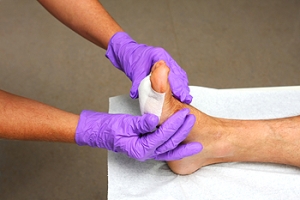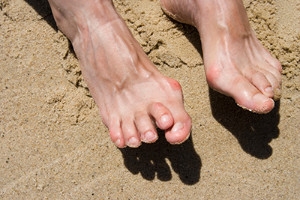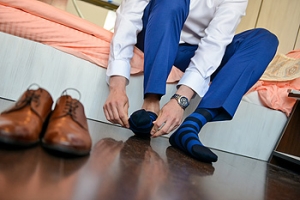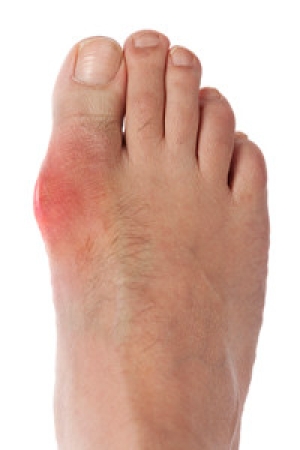
Diabetes and Wound Care
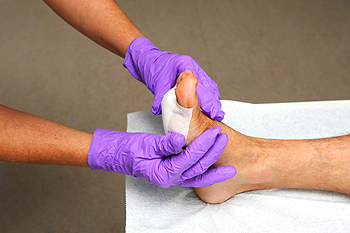 It’s important for most people to check their feet frequently for abnormal conditions, and this is especially true for diabetic patients. If cuts, scrapes and blisters are not noticed, the chances of developing an infection may be amplified because of the body’s inability to heal efficiently. If there are wounds on the feet, recent research has shown the importance of resting frequently, which takes pressure off of the affected area. If you notice cuts on your feet and ankles, it’s suggested to consult with a podiatrist as quickly as possible. At this time a treatment plan can be discussed, which may include what type of wound dressing to use and how often it should be changed. It may be helpful to the patient and may aid in the healing process if the blood sugar levels can be controlled by maintaining a healthy diet and gentle exercise plan.
It’s important for most people to check their feet frequently for abnormal conditions, and this is especially true for diabetic patients. If cuts, scrapes and blisters are not noticed, the chances of developing an infection may be amplified because of the body’s inability to heal efficiently. If there are wounds on the feet, recent research has shown the importance of resting frequently, which takes pressure off of the affected area. If you notice cuts on your feet and ankles, it’s suggested to consult with a podiatrist as quickly as possible. At this time a treatment plan can be discussed, which may include what type of wound dressing to use and how often it should be changed. It may be helpful to the patient and may aid in the healing process if the blood sugar levels can be controlled by maintaining a healthy diet and gentle exercise plan.
Wound care is an important part in dealing with diabetes. If you have diabetes and a foot wound or would like more information about wound care for diabetics, consult with Dr. Lee R. Stein from Lake Shore Foot & Ankle, PC. Our doctor will assess your condition and provide you with quality foot and ankle treatment.
What Is Wound Care?
Wound care is the practice of taking proper care of a wound. This can range from the smallest to the largest of wounds. While everyone can benefit from proper wound care, it is much more important for diabetics. Diabetics often suffer from poor blood circulation which causes wounds to heal much slower than they would in a non-diabetic.
What Is the Importance of Wound Care?
While it may not seem apparent with small ulcers on the foot, for diabetics, any size ulcer can become infected. Diabetics often also suffer from neuropathy, or nerve loss. This means they might not even feel when they have an ulcer on their foot. If the wound becomes severely infected, amputation may be necessary. Therefore, it is of the upmost importance to properly care for any and all foot wounds.
How to Care for Wounds
The best way to care for foot wounds is to prevent them. For diabetics, this means daily inspections of the feet for any signs of abnormalities or ulcers. It is also recommended to see a podiatrist several times a year for a foot inspection. If you do have an ulcer, run the wound under water to clear dirt from the wound; then apply antibiotic ointment to the wound and cover with a bandage. Bandages should be changed daily and keeping pressure off the wound is smart. It is advised to see a podiatrist, who can keep an eye on it.
If you have any questions, please feel free to contact one of our offices located in Chicago, Highland Park, and Uptown, IL . We offer the newest diagnostic and treatment technologies for all your foot care needs.
Wound Care
Diabetics must be wary of all wounds, regardless of depth or size. Diabetes, a chronic disease in which the body cannot properly use glucose the way it normally would, causes various complications that make wounds difficult to heal. Nerve damage or neuropathy will cause diabetics to have trouble feeling the pain of a blister or cut until the condition has significantly worsened or become infected. A diabetic’s weakened immune system can make even the most minor of wounds easily susceptible to infection. Diabetics are also more prone to developing narrow, clogged arteries, and are therefore more likely to develop wounds.
Wounds should be taken care of immediately after discovery, as even the smallest of wounds can become infected if enough bacteria build up within the wound. To remove dirt, wounds should be first rinsed under running water only. Soap, hydrogen peroxide, or iodine can irritate the injury and should be avoided. To prevent infection, apply antibiotic ointment to the wound and cover it with a bandage. The bandage should be changed daily. The skin around the wound may be cleaned with soap.
To prevent further exacerbation, see a doctor—especially if you have diabetes. Minor skin conditions can become larger problems if not properly inspected. As the wound heals, make sure to avoid applying pressure to the affected area.
The Causes of Hammertoe
 Research has shown the main cause for developing the foot condition known as hammertoe originates from wearing poorly fitting shoes. Shoes that have little or no arch may cause the middle joint in the toe to bend downward abnormally, and this may cause the bent toe to resemble a hammer. This condition typically causes severe pain and discomfort, and may affect the surrounding muscles that are used to keep the toe straight. There may be several reasons why this muscle imbalance occurs, including wearing shoes that do not have adequate room for the toes to move about, having specific diseases such as diabetes or arthritis, or genetic factors. Some of the symptoms that may accompany this ailment may include redness and swelling, open sores on the affected toe, and noticeable pain and discomfort. Certain measures are typically taken to treat hammertoe, and these may include performing gentle foot exercises that incorporate the muscles of the toes, in addition to choosing proper footwear. It’s important to speak with a podiatrist who can determine a treatment plan that is best for you as quickly as possible.
Research has shown the main cause for developing the foot condition known as hammertoe originates from wearing poorly fitting shoes. Shoes that have little or no arch may cause the middle joint in the toe to bend downward abnormally, and this may cause the bent toe to resemble a hammer. This condition typically causes severe pain and discomfort, and may affect the surrounding muscles that are used to keep the toe straight. There may be several reasons why this muscle imbalance occurs, including wearing shoes that do not have adequate room for the toes to move about, having specific diseases such as diabetes or arthritis, or genetic factors. Some of the symptoms that may accompany this ailment may include redness and swelling, open sores on the affected toe, and noticeable pain and discomfort. Certain measures are typically taken to treat hammertoe, and these may include performing gentle foot exercises that incorporate the muscles of the toes, in addition to choosing proper footwear. It’s important to speak with a podiatrist who can determine a treatment plan that is best for you as quickly as possible.
Hammertoes can be a painful condition to live with. For more information, contact Dr. Lee R. Stein of Lake Shore Foot & Ankle, PC. Our doctor will answer any of your foot- and ankle-related questions.
Hammertoe
Hammertoe is a foot deformity that occurs due to an imbalance in the muscles, tendons, or ligaments that normally hold the toe straight. It can be caused by the type of shoes you wear, your foot structure, trauma, and certain disease processes.
Symptoms
- Painful and/or difficult toe movement
- Swelling
- Joint stiffness
- Calluses/Corns
- Physical deformity
Risk Factors
- Age – The risk of hammertoe increases with age
- Sex – Women are more likely to have hammertoe compared to men
- Toe Length – You are more likely to develop hammertoe if your second toe is longer than your big toe
- Certain Diseases – Arthritis and diabetes may make you more likely to develop hammertoe
Treatment
If you have hammertoe, you should change into a more comfortable shoe that provides enough room for your toes. Exercises such as picking up marbles may strengthen and stretch your toe muscles. Nevertheless, it is important to seek assistance from a podiatrist in order to determine the severity of your hammertoe and see which treatment option will work best for you.
If you have any questions, please feel free to contact one of our offices located in Chicago, Highland Park, and Uptown, IL . We offer the newest diagnostic and treatment technologies for all your foot care needs.
Hammertoe
Hammertoe is a foot deformity that occurs due to an imbalance in the tendons, muscles, or ligaments that are responsible for holding the toes in their normal position. This condition may be caused by poor footwear, foot structure, trauma, and disease. The most common solution for hammertoe is to relieve the pain by changing your footwear and wearing orthotics. In severe cases, surgery may be required.
The shoes that are most likely to cause hammertoe are high heeled shoes or shoes that are too tight in the toe box. Tight shoes will force your toes to crowd together in a curled position. This position will likely continue when you take your shoes off. Another cause is trauma. When you stub your toe, you are increasing the chance that you will develop hammertoe.
There are risk factors that may make you more likely to develop this condition. Women are more likely to have the condition compared to men, and it is also more likely to appear in those who are older in age.
Many different foot problems can be avoided by wearing shoes that have adjustability, adequate toe room, and low heels. Furthermore, if you want to buy new shoes, you should look to purchase them at the end of the day and make sure you know your correct size. The importance of buying shoes at the end of the day is that your feet swell as the day progresses. You should also ensure that you are wearing your correct size because your shoe size may change as you grow older.
To diagnose someone with hammertoe, your podiatrist will need to conduct a thorough examination of your foot. Your doctor may even order an x-ray to evaluate the bones and joints of your feet and toes.
If you have hammertoe, your podiatrist may recommend that you wear shoes that fit you better along with inserts to place inside them. Additionally, he or she may suggest special exercises for you to perform to stretch your toes. One helpful exercise it to pick up marbles with your feet or crumple a towel with your toes.
Prior to meeting with your podiatrist, it will be helpful to make a list of all the symptoms you are experiencing. You should also make a note of medications you are taking and important personal information about your medical history.
How to Tell If You Have Plantar Fasciitis
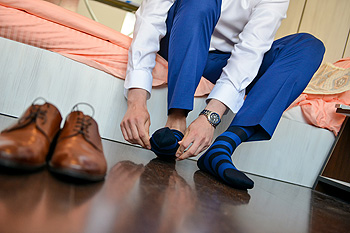 The plantar fascia is a long ligament that runs along the bottom of the foot. This ligament is responsible for connecting the heel to the front of the foot, and it supports the foot’s arch. Plantar fasciitis is the number one cause of heel pain. It has been estimated that approximately 2 million people each year are treated for this condition. You will be more likely to develop plantar fasciitis if you are obese, have a high foot arch, are involved in sports, or have tighter calf muscles. Many people who have plantar fasciitis also have heel spurs, but heel spurs are not the cause of plantar fasciitis. Symptoms of plantar fasciitis include pain near the heel, pain after getting up in the morning, and pain after exercising. If you suspect that you may have plantar fasciitis, you should speak with your podiatrist to explore treatment options that could potentially work for you.
The plantar fascia is a long ligament that runs along the bottom of the foot. This ligament is responsible for connecting the heel to the front of the foot, and it supports the foot’s arch. Plantar fasciitis is the number one cause of heel pain. It has been estimated that approximately 2 million people each year are treated for this condition. You will be more likely to develop plantar fasciitis if you are obese, have a high foot arch, are involved in sports, or have tighter calf muscles. Many people who have plantar fasciitis also have heel spurs, but heel spurs are not the cause of plantar fasciitis. Symptoms of plantar fasciitis include pain near the heel, pain after getting up in the morning, and pain after exercising. If you suspect that you may have plantar fasciitis, you should speak with your podiatrist to explore treatment options that could potentially work for you.
Plantar fasciitis can be very painful and inconvenient. If you are experiencing heel pain or symptoms of plantar fasciitis, contact Dr. Lee R. Stein from Lake Shore Foot & Ankle, PC. Our doctor can provide the care you need to keep you pain-free and on your feet.
What Is Plantar Fasciitis?
Plantar fasciitis is the inflammation of the thick band of tissue that runs along the bottom of your foot, known as the plantar fascia, and causes mild to severe heel pain.
What Causes Plantar Fasciitis?
- Excessive running
- Non-supportive shoes
- Overpronation
- Repeated stretching and tearing of the plantar fascia
How Can It Be Treated?
- Conservative measures – anti-inflammatories, ice packs, stretching exercises, physical therapy, orthotic devices
- Shockwave therapy – sound waves are sent to the affected area to facilitate healing and are usually used for chronic cases of plantar fasciitis
- Surgery – usually only used as a last resort when all else fails. The plantar fascia can be surgically detached from the heel
While very treatable, plantar fasciitis is definitely not something that should be ignored. Especially in severe cases, speaking to your doctor right away is highly recommended to avoid complications and severe heel pain. Your podiatrist can work with you to provide the appropriate treatment options tailored to your condition.
If you have any questions please feel free to contact one of our offices located in Chicago, Highland Park, and Uptown, IL . We offer the newest diagnostic and treatment technologies for all your foot and ankle needs.
Plantar Fasciitis
The plantar fascia is a connective tissue in the heel that stretches across the bottom length of your foot. Plantar fasciitis occurs when the connective tissue becomes inflamed, causing heel pain and discomfort during physical activity. Although the condition is completely treatable, traditional methods can take up to a year to start becoming effective.
Plantar fasciitis is caused by a number of everyday activities, so understanding the condition is important for managing and treating it. One of the most common causes of plantar fasciitis is excessive running, especially with improper fitting or non-supportive shoes. Too much exercise can lead to the plantar fascia being overworked and overstretched, which can cause tears in the tissue. Along with improper fitting shoes, pronation, the rolling of the feet inward, is a common cause of plantar fasciitis. If not treated properly, the plantar fascia becomes overstretched and starts to tear, causing inflammation.
Despite the common causes of plantar fasciitis, there are many different treatment options. For less severe cases, conservative home remedies include taking anti-inflammatory drugs to alleviate pain, applying ice packs to the bottom of your foot and heel, slowly stretching and exercising your feet to re-strengthen the tissue, and using orthotic devices are all ways to help manage your plantar fasciitis.
For more severe cases, shockwave therapy has become a common solution for plantar fasciitis. Shockwave therapy can effectively break up the tissue on the bottom of your foot which facilitates healing and regeneration. This fights the chronic pain caused by plantar fasciitis. Even if this doesn’t work, surgery is always a final option. Surgery on the tissue itself can be done to permanently correct the issue and stop the inflammation and pain in your heels.
No matter what the case may be, consulting your podiatrist is the first and best step to recovery. Even the slightest amount of heel pain could be the first stage of plantar fasciitis. Untreated symptoms can lead to the tearing and overstretching of tissue. Because the tearing of tissue can be compounded if it remains ignored, it can evolve into a severe case. The solution is early detection and early treatment. Talk to your podiatrist about the possibilities of plantar fasciitis if you’re experiencing heel pain.
Possible Causes of Gout
 A form of arthritis that attacks the joints in the big toe is often referred to as gout. This condition may typically occur abruptly, and obvious symptoms may include severe pain and discomfort, swollen joints, and redness. It develops as a result of excess uric acid in the blood, which can form crystals in the joints. This may occur because of specific foods that are ingested, including an overabundance of shellfish, alcohol, or red meat. Some patients may develop this ailment from inherited genes, being overweight, and taking certain medications. If you are afflicted by this type of arthritis, it’s important that it is treated as quickly as possible, to avoid the development of additional complications. Please speak with a podiatrist about the treatment options that are right for you.
A form of arthritis that attacks the joints in the big toe is often referred to as gout. This condition may typically occur abruptly, and obvious symptoms may include severe pain and discomfort, swollen joints, and redness. It develops as a result of excess uric acid in the blood, which can form crystals in the joints. This may occur because of specific foods that are ingested, including an overabundance of shellfish, alcohol, or red meat. Some patients may develop this ailment from inherited genes, being overweight, and taking certain medications. If you are afflicted by this type of arthritis, it’s important that it is treated as quickly as possible, to avoid the development of additional complications. Please speak with a podiatrist about the treatment options that are right for you.
Gout is a painful condition that can be treated. If you are seeking treatment, contact Dr. Lee R. Stein from Lake Shore Foot & Ankle, PC. Our doctor will treat your foot and ankle needs.
What Is Gout?
Gout is a form of arthritis that is characterized by sudden, severe attacks of pain, redness, and tenderness in the joints. The condition usually affects the joint at the base of the big toe. A gout attack can occur at any random time, such as the middle of the night while you are asleep.
Symptoms
- Intense Joint Pain - Usually around the large joint of your big toe, and it most severe within the first four to twelve hours
- Lingering Discomfort - Joint discomfort may last from a few days to a few weeks
- Inflammation and Redness -Affected joints may become swollen, tender, warm and red
- Limited Range of Motion - May experience a decrease in joint mobility
Risk Factors
- Genetics - If family members have gout, you’re more likely to have it
- Medications - Diuretic medications can raise uric acid levels
- Gender/Age - Gout is more common in men until the age of 60. It is believed that estrogen protects women until that point
- Diet - Eating red meat and shellfish increases your risk
- Alcohol - Having more than two alcoholic drinks per day increases your risk
- Obesity - Obese people are at a higher risk for gout
Prior to visiting your podiatrist to receive treatment for gout, there are a few things you should do beforehand. If you have gout you should write down your symptoms--including when they started and how often you experience them, important medical information you may have, and any questions you may have. Writing down these three things will help your podiatrist in assessing your specific situation so that he or she may provide the best route of treatment for you.
If you have any questions, please feel free to contact one of our offices located in Chicago, Highland Park, and Uptown, IL . We offer the newest diagnostic and treatment technologies for all your foot care needs.
Gout
Gout is a form of arthritis that is caused by a buildup of uric acid crystals in the joints. This considered to be one of the most frequently recorded medical illnesses throughout history. Gout occurrences in the US have risen within the past twenty years and the condition now affects 8.3 million people which is 4% of all Americans. Researchers have found that gout affects men more than women and African-American men more than white men.
Symptoms of gout are warmth, swelling, discoloration, and tenderness in the affected joint area. The small joint on the big toe is the most common place for a gout attack to occur.
People who are obese, gain weight excessively, drink alcohol heavily, have high blood pressure, or have abnormal kidney function are more likely to develop gout. Furthermore, certain drugs and diseases are likely to increase levels of uric acid in the joints which eventually leads to gout. You are also more likely to develop gout if you eat a lot of meat and fish.
Many who experience gout attacks will experience repeated attacks over the years. Some people who have gout symptoms, may never have them again, but others may experience them several times a year. If you have gout symptoms throughout the year, you may have recurrent gout. Those who have gout should also be careful about their urate crystals collecting in their urinary tract, because this may lead to kidney stones.
Diagnosis for gout is done by checking the level of uric acid in the joints and blood. Your podiatrist may also prescribe medicine to reduce uric acid buildup in the blood, which will help prevent any gout attacks.
To treat gout, your podiatrist may also prescribe you Anti-inflammatory medication (NSAIDs) which will relieve the pain and swelling of a gout episode and it can also shorten a gout attack. Maintaining a healthy diet is also a proven method to prevent gout attacks.





